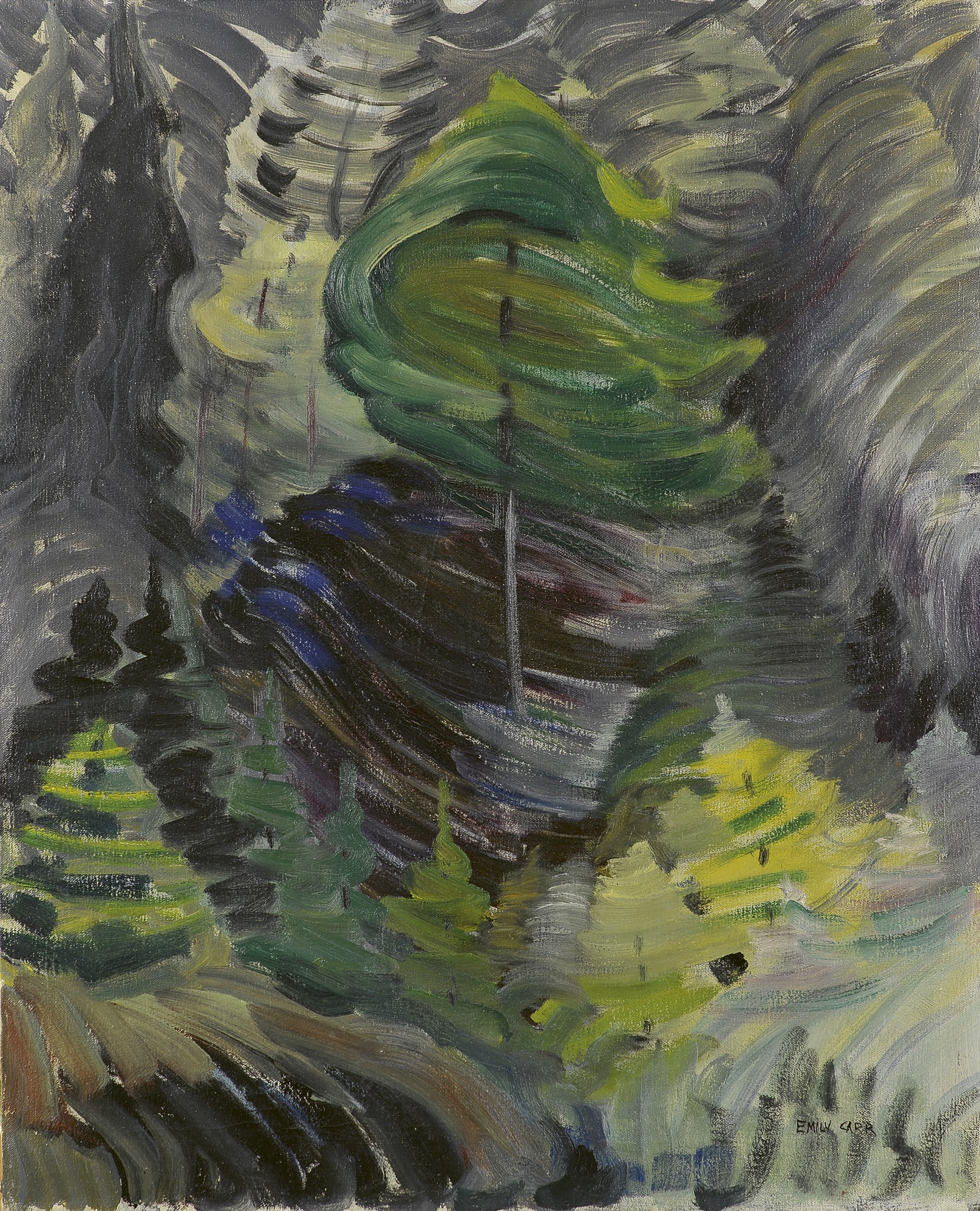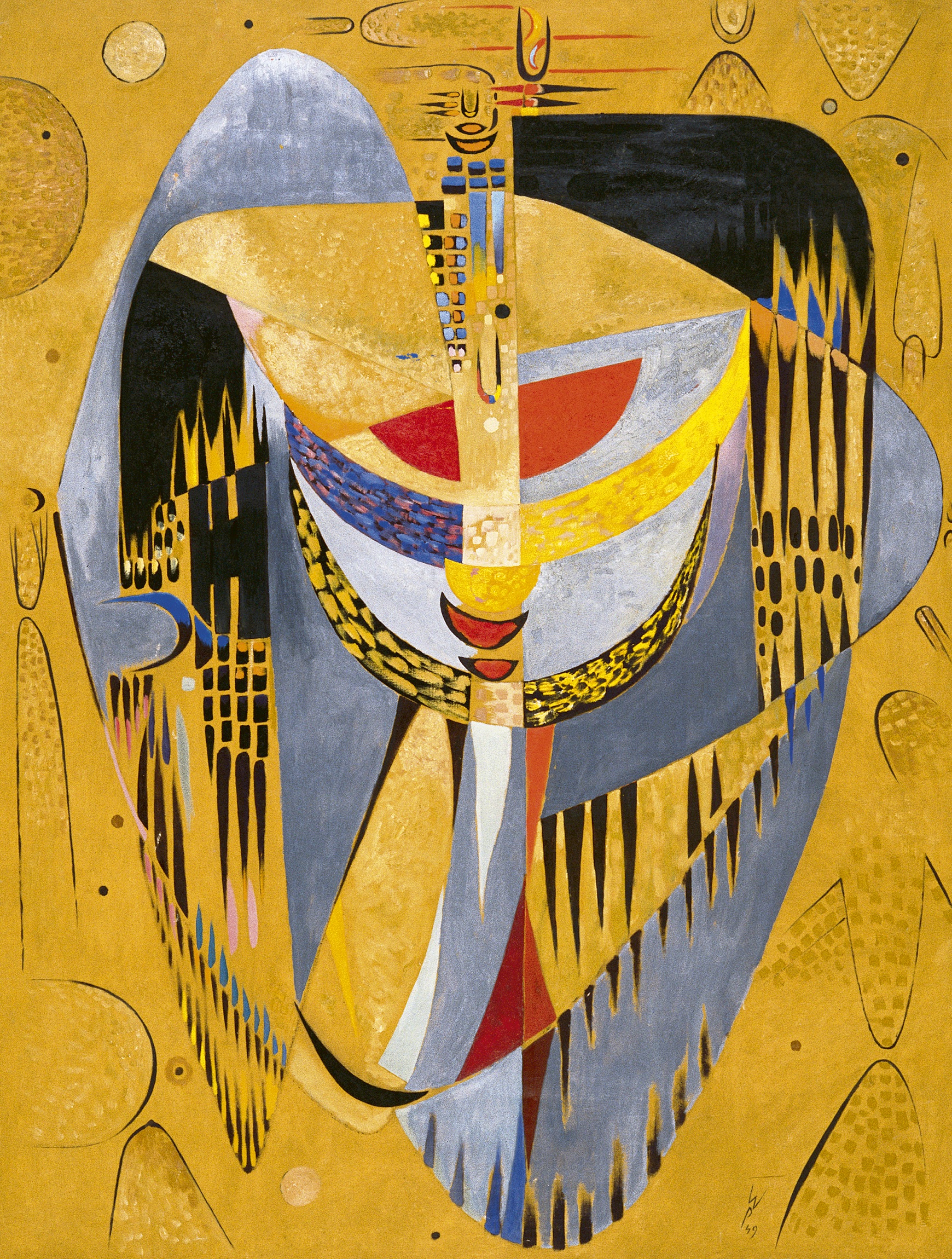
Emily Carr. Juice of Life, 1938–39. Oil on canvas . Collection of the Art Gallery of Greater Victoria, Gift of Dr. Ethlyn Trapp, Vancouver. Photo: Stephen Topfer, Art Gallery of Greater Victoria.
For years, their encounter was relegated to a footnote. In August 1939, just over two weeks before Canada declared war on Germany, the modernist painter Emily Carr opened the door of her cottage in Victoria, British Columbia, to one of the bright young surrealists of Paris. Wolfgang Paalen, his wife Alice Rahon, and their companion Eva Sulzer were concluding a three-month journey to the Northwest Coast of North America, visiting Indigenous villages from Alaska to Vancouver Island, many of which Carr had visited thirty years earlier as she embarked on her project of documenting every remaining totem pole in situ.
At sixty-eight, Carr was twice Paalen’s age. She was a demanding, disciplined, self-critical artist with little patience for the erotic excesses of Surrealism, although she was no prude. Her favorite literary companion was Walt Whitman. She’d just finished reading Gertrude Stein’s Picasso. Encouraged by Lawren Harris, she had shifted her attention from depicting the monumental art of the Northwest Coast to focusing on the forest, testing the possibilities of abstraction through depicting shafts of light and flaps of vegetation and working quickly on paper with gasoline-thinned paint in order to loosen up her technique. She was seeking a way to coax the rushing movement of the divine onto the canvas. Paalen understood immediately that she was struggling to integrate inner and outer visions. I imagine Carr excitedly pulling out canvases to show her visitors from Paris. To John Davis Hatch, the director of the Albany Institute of History and Art in New York, she later wrote, “I can’t get the surrealist point of view; most of their subjects revolt me…To my surprise Mr. Paalen was very enthusiastic about my work. I felt like a hayseed but he found something in it.”
Like Carr, Paalen was disciplined and restless. As he left Paris, he was on the verge of renouncing Surrealism. He’d begun to conceive of contemporary art as a catalyst for human possibility. The journey to the Northwest Coast—writing notes, taking pictures, shooting 8-mm movies and visiting Indigenous villages—was as much a flight from Europe and the approaching war as it was an opportunity for renewal. Paalen longed to stand among the monumental poles of the Northwest Coast, to breathe the air the great carvers had breathed in, and to immerse himself in a living world of ancestors. The works painted prior to his departure, such as the Combats des princes saturniens and Orages magnétique, with their terrifying prophecy of the catastrophe to come, represent his state of mind as he set sail for North America.
Paalen, Rahon, and Sulzer eventually settled in Mexico City. Paalen established a studio and began the most productive period of his life, producing paintings and drawings, theoretical articles on contemporary art, and five issues of his innovative journal, Dyn. In Paris, he had painted a series of surrealist works he called Paysages totémique and Paysages totémique de mon enfance. Now he began to explore the possibilities generated by his experience of the Northwest Coast. “This is the moment to integrate the enormous treasure of Amerindian forms into the consciousness of modern art,” he wrote in 1943. He began to imagine a contemporary art of the possible, in which human consciousness would regard itself as inseparable from the invisible, elemental energies of the cosmos. The works Polaritiés chromatique and Éspace libre present whirling forms and parabolas that suggest every moment is a moment of origin. In later works like Les cosmogones, one encounters massive energies, unexpected colors, and great ancestral figures integrated into a surging blizzard of paint. Carr would have understood Paalen’s attraction to quantum theory. Addressing herself in her journal in 1931, she wrote, “Go out there into the glory of the woods. See God in every particle of them expressing glory and strength and power, tenderness and protection.” Both artists strove to reveal the invisible within the visible. Paalen’s influence on Abstract Expressionism was considerable. “Paintings no longer represent,” he wrote in 1945, “it is no longer the task of art to answer naive questions. Today it has become the role of the painting to look at the spectator and ask him: what do you represent?”

Wolfgang Paalen. Messagers des trois pôles, 1949. Oil on canvas. Collection of Lucid Art Foundation.
Editor’s note: This text was excerpted from a talk given by the author in conjunction with the exhibition he curated, I Had an Interesting French Artist to See Me This Summer: Emily Carr and Wolfgang Paalen in British Columbia at the Vancouver Art Gallery, June 1 – November 13, 2016.




